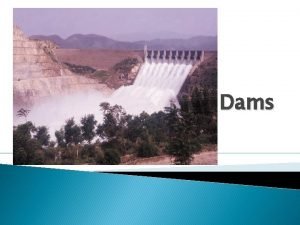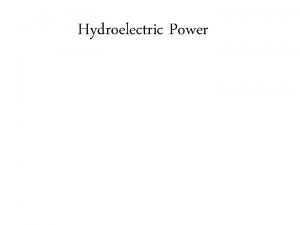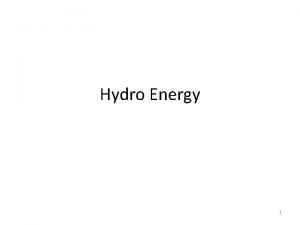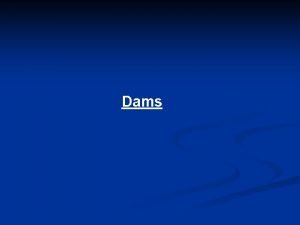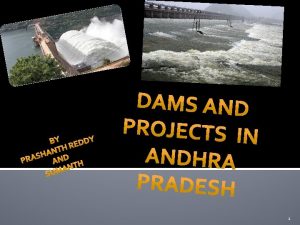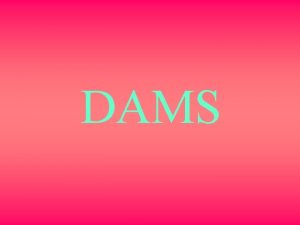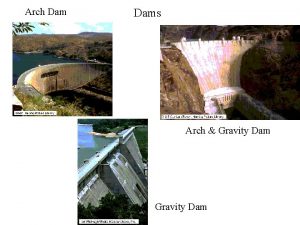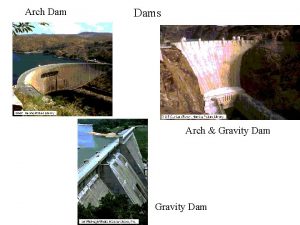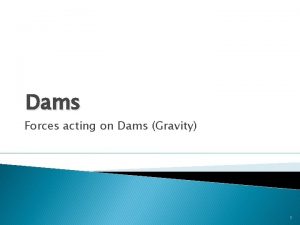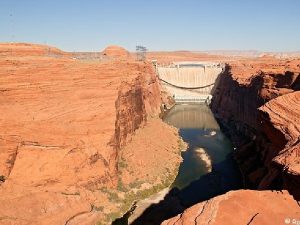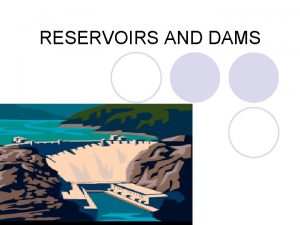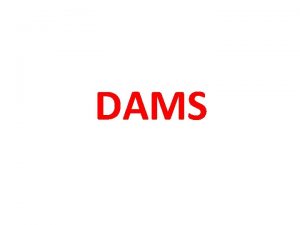DAMS TERMINOLOGY for DAMS n n n n






































- Slides: 38

DAMS

TERMINOLOGY for DAMS n n n n n Dam. . . . baraj Small dam. . . bent veya gölet Reservoir. . . hazne veya göl alanı Leakage. . . su kaçağı Seepage. . . sızma Storage. . . . depolama Coffer dam. . . batardo Upstream coffer dam. . . . memba batardosu Downstream coffer dam. . . mansap batardosu Core. . . . baraj çekirdeği Filter. . . . filtre veya geçirgen katman Diversion tunnel. . . . . derivasyon tüneli – çevirme tüneli Rip-rap. . . . koruyucu kaya dolgu Cut-off. . . . hendek Toe-drain. . . topuk drenajı Right side. . . sağ yan – sağ sahil Left side. . . sol yan – sol sahil

n n n n n River side. . . . . nehir içi Butress. . . . . payanda Foundation. . . . . temel Embankment. . . . sedde Base-width. . . . . taban genişliği Crest. . . tepe Cut-off trench. . . . saplama hendeği Expansion joint. . . . genişleme derzi (dilatasyon) Spillway. . . . . dolusavak Gravity dam. . . . ağırlık barajı Tail water. . . . . çıkan su Head water. . . . . giren su Arch dam. . . . . kemer baraj Abutment. . . . . yan dayanak Multiple arch dam. . . çok kemerli baraj veya payandalı baraj Extrados. . . . . dış yüzey Intrados. . . . . iç yüzey

n n n n Parapet. . . korkuluk Rock fill dam. . . . . kaya dolgu baraj Compacted rock fill. . . . sıkıştırılmış kaya dolgu Dumped rock fill. . . . dökme kaya dolgu Foot wall. . . topuk duvarı Earth dam. . . toprak baraj Watertight core. . . . geçirimsiz çekirdek Watertight diaphram. . . geçirimsiz perde Retaining wall. . . . . istinat (dayanma) duvarı Hard ground. . . . . sağlam zemin Impervious ground. . . . geçirimsiz zemin Grout curtain. . . . . enjeksiyon (harçlama) perdesi Overburden. . . . . sıyrılacak katman Bedrock. . . yerli kaya

DISTRIBUTION of WATER RESOURCES


n In Turkey, 536 large dams have been built and being operated. On the other hand, Small Hydraulic Works Department has built 42 small dams. n Here, 50 storage facilities that are not considered as dam due to their low heights (<15 m) and low storage capatcities (<2 hm 3) have not been taken into account. n By now, construction of 100 dams and hydroelectric powerplants is going on.

Definition n A dam is a structure which prevents the flow of water and accumulates it in a reservoir Karakaya Dam/Diyarbakır Atatürk Dam/Şanlıurfa

Needs for Dam Construction 1. 2. 3. 4. 5. 6. Drinking and domestic water supply Flood control Irrigation Industrial water supply Hydroelectric energy production Retention and control of sediments and Inland navigation, Improvement of water quality, Fish Farming, Recreation facilities

BREAKDOWN by PURPOSE of DAMS in EUROPE

CLASSIFICATION OF DAMS

ACCORDING to the SIZE of the DAM 1. 2. Large (Big) dam Small dam n International Commision on Large Dams, (ICOLD) assumes a dam as big when its height is bigger than 15 m. n If the height of the dam is between 10 m and 15 m and matches the following criteria, then ICOLD accepts the dam as big: n n If the crest length is bigger than 500 m If the reservoir capacity is larger than 1 million m 3 If the flood discharge is more than 2000 m 3/s If there are some difficulties in the construction of foundation

ACCORDING to HEIGHT of DAM n High Dam or Large Dam n n Medium Dam n n If the height of the dam is bigger than 100 m If the height of the dam is between 50 m and 100 m Low Dam or Small Dam n If the height of the dam is lower than 50 m

ACCORDING to the STATICAL DESIGN of DAM BODY n Gravity Dams n Arch Dams n Butress Dams Embankment Dams Composite Dams n n (Sarıyar, Çubuk I, Kemer, Sır II Karacaören II) (Gökçekaya, Karakaya, Oymapınar, Gezende) (Elmalı II) (Atatürk, Seyhan, Aslantaş) (Keban)

GRAVITY DAMS n Gravity Dams use their triangular shape and the sheer weight of their rock and concrete structure to hold back the water in the reservoir. Sarıyar Dam – Sakarya River; Height= 90 m Reservoir Capacity= 1. 9 billion m 3


ARCH DAMS n Arch Dams utilize the strength of an arch to displace the load of water behind it onto the rock walls that it is built into. Karakaya Dam – Fırat River; Height= 173 m Reservoir Capacity= 9, 5 billion m 3

BUTRESS DAMS n Buttress Dams use multiple reinforced columns to support a dam that has a relatively thin structure. Because of this, these dams often use half as much concrete as gravity dams Elmalı II – Göksu River; Height= 42. 5 m Reservoir Capacity= 10 million m 3

EMBANKMENT DAMS (Rock Fill or Earth Fill Dams) n n n They are mostly composed of natural materials such as, clay, sand, gravel etc. . . Impervious core is placed in the middle of the embankment body Generally riprap is used to control erosion Atatürk Dam – Fırat River; Height= 169 m; Reservoir Capacity= 48, 7 billion m 3

COMPOSITE DAMS n Composite dams are combinations of one or more dam types. Most often a large section of a dam will be either an embankment or gravity dam, with the section responsible for power generation being a buttress or arch. Keban Dam – Fırat River; Height= 163 m; Reservoir Capacity= 31 billion m 3 Gravity & Rock Fill

ENGINEERING GEOLOGICAL STUDIES for DAM CONSTRUCTION

1. RECONNAISSANCE STUDY 1. 2. 3. 4. Evaluation of the data having at archives of MTA, DSI, EIE, Universities, . . . etc Field investigation for limited time (Reconnaissance Study) Some maps in small scale, for example 1/25. 000 or 1/50. 000 Some hydraulic data about a. b. c. d. 5. 6. 7. Basin Precipitation area Runoff, maximum discharge {Q=R/t (m 3/s)} Modulus of Runoff (R/t/m 2 ~ R/t/km 2) Some approach to the reservoir area, dam site and type of dam and height of dam. . . etc Photogeological studies A preliminary report

2. PRELIMINARY STUDIES at the RESERVOIR AREA and DAM SITE 1. Dam site investigations 1. 2. 3. 4. Location of dam axis Location of diversion tunnel Location of spillway Location of powerhouse. . . etc Geological studies Geophysical surveying Underground investigations 1. Boreholes 2. Investigation galleries 3. Pitholes 5. Surveying for materials 1. Field surveying 2. Laboratory tests

6. 7. 8. 9. 10. 11. Slope stability investigations Earthquake hazard & risk analysis Environmental studies Leakage possibilities from reservoir area Leakage possibilities from dam site Erosion, sedimentation & siltation

DETAILED INVESTIGATION at DAM SITE 1. Topographic surveyings 2. Geological mappings 1/5000 – 1/1000 or 1/500 3. Underground explorations Boreholes, adits. . etc 4. Hydrogeological studies 5. Slope stability analysis

FACTORS AFFECTING to the DAM TYPE SELECTION n n Topography Geology n n n Bearing capacity of the underlying soil Foundation settlements Permeability of the foundation soil Material availability Spillway position Earthquakes Safety Height Aesthetic view Qualified labour Cost

FACTORS AFFECTING to the PLACE of the DAM AXIS n n n n n Topography Geology Materials Spillway location availability Derivation Sediments in the flowing water Water quality Expropriation costs Earthquake possibility Downstream water rights

RIVER BASINS in TURKEY Turkey has been separated into 26 main river basins for the hydrological studies.

ENVIRONMENTAL IMPACTS OF DAMS

ENVIRONMENTAL IMPACTS of CONSTRUCTION PHASE of DAMS River pollution n Erosion n Loss of aesthetic view n Air pollution n Noise pollution n Dust n

ENVIRONMENTAL IMPACTS of RESERVOIRS n n Loss of land Habitat Destruction : n n n n n The area that is covered by the reservoir is destroyed, killing whatever habitat existed there beforehand. Loss of archeological and histrorical places Loss of mineral deposits Loss of special geological formations Aesthetic view reduction Sedimentation Change in river flow regime and flood effects Reservoir induced seismicity Change in climate and plant species

EFFECTS of DAMS to WATER QUALITY n n n Change in temperature Turbidity Dissolved gases in the water n n Water discharged from the spillway contains 110 -120% saturated nitrogen. This amount may be destructive for fish life. Eutrophication n It means increase in vegetation. If moss and other plants exist in water, quality of that water gets worse.

SOME DAMS from SPACE





 Uplift force on dam
Uplift force on dam Overflow dam and non overflow dam
Overflow dam and non overflow dam Tasmanian dams case
Tasmanian dams case Forces acting on dams
Forces acting on dams Vertical gates in dams
Vertical gates in dams Types of dams
Types of dams Function of spillway
Function of spillway Advantages and disadvantages of dams
Advantages and disadvantages of dams Nick dams
Nick dams How do dams generate electricity brainpop
How do dams generate electricity brainpop Uses of dams
Uses of dams Roma tre dams
Roma tre dams Dams roma tre
Dams roma tre Fdr election map
Fdr election map Rita perspektiv
Rita perspektiv Ekologiskt fotavtryck
Ekologiskt fotavtryck Redogör för vad psykologi är
Redogör för vad psykologi är Geometri för barn
Geometri för barn Claes martinsson
Claes martinsson Nyckelkompetenser för livslångt lärande
Nyckelkompetenser för livslångt lärande Publik sektor
Publik sektor Form dikt
Form dikt Mantel som bars av kvinnor i antikens rom
Mantel som bars av kvinnor i antikens rom Tidbok yrkesförare
Tidbok yrkesförare Datumr
Datumr Orubbliga rättigheter
Orubbliga rättigheter Verktyg för automatisering av utbetalningar
Verktyg för automatisering av utbetalningar Ministerstyre för och nackdelar
Ministerstyre för och nackdelar Bamse för de yngsta
Bamse för de yngsta Plats för toran ark
Plats för toran ark Expektans
Expektans Tillitsbaserad ledning
Tillitsbaserad ledning Sju för caesar
Sju för caesar Tack för att ni lyssnade bild
Tack för att ni lyssnade bild Informationskartläggning
Informationskartläggning Varför kallas perioden 1918-1939 för mellankrigstiden
Varför kallas perioden 1918-1939 för mellankrigstiden Stål för stötfångarsystem
Stål för stötfångarsystem Shivaismen
Shivaismen Centrum för kunskap och säkerhet
Centrum för kunskap och säkerhet

